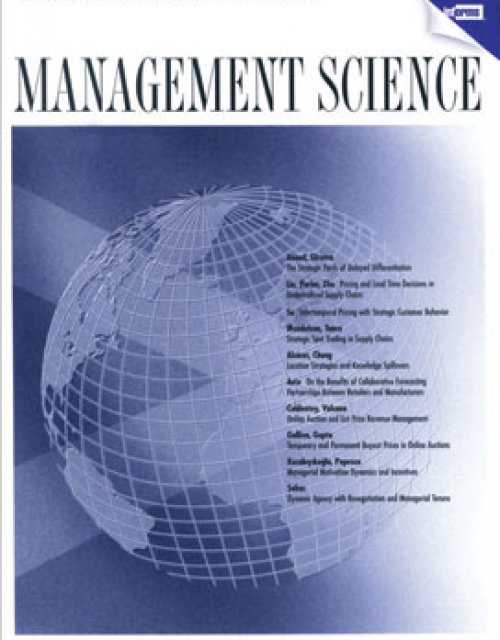Publication records
Subject(s)
Entrepreneurship
Keyword(s)
Microeconomic behavior, industrial organization, firm objectives, organization and behavior, market structure, firm strategy, market performance, patent system, patent litigation
JEL Code(s)
K11, K41, O34
Postgrant validity challenges at patent offices rely on the private initiative of third parties to correct mistakes made by patent offices. We hypothesize that incentives to bring postgrant validity challenges are reduced when many firms benefit from revocation of a patent and when firms are caught up in patent thickets. Using data on opposition to patents at the European Patent Office we show that opposition decreases in fields in which many others profit from patent revocations. Moreover, in fields with a large number of mutually blocking patents, the incidence of opposition is sharply reduced, particularly among large firms and firms that are caught up directly in patent thickets. These findings indicate that postgrant patent review may not constitute an effective correction device for erroneous patent grants in technologies affected by either patent thickets or highly dispersed patent ownership.
© 2016 INFORMS
Volume
62
Journal Pages
704–721
Subject(s)
Entrepreneurship; Technology, R&D management
Keyword(s)
Patent indicators, patent system, product commercialization, pharmaceutical industry, drug development
Patent-based measures are frequently used as indicators in empirical research on innovation and technological change. Currently, there is little evidence as to what extent patent-based indicators relate to product market outcomes. Using a unique dataset that links outcomes from product commercialization in the pharmaceutical industry with detailed patent data, we relate patent-based indicators that capture either an invention’s value or the uncertainty surrounding the patenting process to the outcomes of the product development process. Our findings suggest that the speed of commercialization increases with value but reduces with uncertainty. Using a variety of alternative indicators we derive implications for the use and the proper interpretation of individual measures. Moreover, our study has broader implications as it highlights the detrimental effect of uncertainty on the speed of innovation.
With permission of Elsevier
Volume
45
Journal Pages
1091–1102
Subject(s)
Economics, politics and business environment
Keyword(s)
distributed energy resources, energy efficiency, energy storage, electric vehicles
Secondary Title
Future of utilities - utilities of the future: How technological innovations in distributed energy resources will reshape the electric power sector
Pages
303–321
ISBN
978-0-12-804249-6
Subject(s)
Strategy and general management
Keyword(s)
Business planning, venture creation, entrepreneurship, start-ups
Zum Werk Businessplanung ist ein essentieller Bestandteil vor, bei und nach der Gründung eines Unternehmens. Selbst nach Etablierung eines Unternehmens sollte ein kontinuierlicher Planungsprozess und damit die Konkretisierung und Quantifizierung von Unternehmenszielen beibehalten werden. Im Mittelpunkt steht die Businessplanung von jungen Unternehmen. Hier ist der Planungsbedarf am größten aber auch zugleich am schwierigsten zu gestalten. Um eine solide Informationsgrundlage für (potenzielle und tatsächliche) Gründer und Jungunternehmer zu haben, werden im vorliegenden Buch die relevanten Bereiche einer adäquaten Geschäftsplanung dargestellt und erläutert. Vorteile auf einen Blick - Schritt für Schritt zum perfekten Businessplan - praxisorientiert und sofort umsetzbar - Tipps für die überzeugende Präsentation vor Investoren und Bankern Zielgruppe Für Existenzgründer und Unternehmer
Volume
3rd ed.,
Pages
180
ISBN
978-3406681080
Subject(s)
Economics, politics and business environment
Keyword(s)
LeChatelier-Samuelson principle, cost passthrough, multiproduct firms
The LeChatelier-Samuelson principle states that as a reaction to a shock, an agent's short-run adjustment of an action is smaller than the long-run adjustment of that action when the other related actions can also be adjusted. We extend the principle to strategic environments and define long run as an adjustment that also includes other players adjusting their strategies. We show that the principle holds for both idiosyncratic shocks (affecting only one player's action directly) and common shocks in supermodular games, only for idiosyncratic shocks in submodular games if the players' payoffs depend only on their own strategies and the sum of the rivals' strategies (for example, homogeneous Cournot oligopoly), and only for idiosyncratic shocks in other games of strategic substitutes or heterogeneity satisfying Morishima Conditions. We argue that the principle might also explain the empirical findings of overshifting of cost and unit tax by multiproduct firms.
View all ESMT Working Papers in the ESMT Working Paper Series here. ESMT Working Papers are also available via SSRN, RePEc, EconStor, and the German National Library (DNB).
Pages
46
ISSN (Print)
1866–3494
Subject(s)
Management sciences, decision sciences and quantitative methods; Product and operations management
Keyword(s)
Technology diffusion, government incentive policies, renewable energy technology, feed-in tariff, learning-by-doing, dynamic programming
Feed-in-tariff (FIT) policies aim at driving down the cost of renewable energies by fostering learning and accelerating the diffusion of green technologies. Under FIT mechanisms, governments purchase green energy at tariffs that are set above market price. The success or failure of FIT policies, in turn, critically depend on how these tariffs are determined and adjusted over time. This paper provides insights into designing cost-efficient and socially-optimal FIT programs. Our modeling framework captures key market dynamics as well as investors' strategic behavior. In this framework, we establish that the current practice of maintaining constant profitability is theoretically rarely optimal. By contrast, we characterize a no-delay region in the problem's parameters, such that profitability should strictly decrease over time if the diffusion and learning rates belong to this region. In this case, investors never strategically postpone their investment to a later period. When the diffusion and learning rates fall outside the region, profitability should increase at least temporarily over some time periods and strategic delays occur. The presence of strategic delays, however, makes the practical problem of computing optimal FIT schedules very difficult. To address this issue, the regulator may focus on policies that disincentivize investors to postpone their investment. With this additional constraint, a constant profitability policy is optimal if and only if the diffusion and learning rates fall outside the no-delay region. This provides partial justifications for current FIT implementations.
© 2015 INFORMS
Volume
64
Journal Pages
52–66
Subject(s)
Technology, R&D management
Volume
26
Journal Pages
8–11
Subject(s)
Human resources management/organizational behavior
Keyword(s)
Change, change management, adaptive change, adaptive leadership, resistance to change, decision making, paradigmatic change, (natural) experiment, scientific method, theory of science, history of science, error management, R&D management
The case provides an example of an individual who meets harsh criticism, personal attacks, and broad resistance despite clear evidence that what he is proposing is right and could save the lives of thousands of human beings. The case recounts the story of Dr. Ignaz Philip Semmelweis, a pioneer in medical antiseptic procedures who is today known as “the savior of mothers.” In 1847, Semmelweis discovered that the practice of hand disinfection in obstetrical clinics can effectively eliminate the outbreak of puerperal fever (“childbed fever”), a condition that killed up to 30 percent of mothers and babies in maternity clinics at the time of the case. The relatively short case – which is designed to be handed out during class – is divided into three parts. Part A describes the situation at Vienna General Hospital in 1846, when Semmelweis is assigned to head one of the two maternity clinics. Much of this part is dedicated to describing the natural experiment that Semmelweis encountered when learning that the two clinics had vastly different mortality rates. Part B lists the many hypotheses that Semmelweis had formulated and refuted, reports on his discovery that the contamination of women by doctors performing anatomical dissections of corpses is causing puerperal fever, and reveals his findings that it can be easily and effectively treated through hand disinfection. Part C provides an account of the resistance he faced from the medical establishment, despite the overwhelming evidence that Semmelweis had collected in support of his findings.
The case has the potential to be an eye-opening experience, as it describes a situation in which the protagonist of change is unable to convince the relevant community, despite having clear evidence: Semmelweis can prove that he is right, but instead of receiving recognition and gratitude and having his recommendations adopted, he meets resistance, personal attack, and ridicule. This is an important lesson for students, who often believe that change can effectively be brought to groups, organizations, and societies when there is clear evidence that proves the integrity of a new proposition.
| buy now | buy now | buy now |
Subject(s)
Information technology and systems; Technology, R&D management
Over the last 10 years, a basic shift has occurred from an IT-deployment view of the world of big systems and even bigger projects toward a people-centric and user-oriented view of hardware, information, and human collaboration and networking. Consumers have adapted rather quickly to this shift: If it is not useful, delete the app, the data, and the humans we choose not to network with.
While consumers are free to pick and choose the technology they will buy, the information they will access, and the degree to which they will network and with whom, managers and employees within companies are more constrained by the processes, structures, functions, systems, and technology the company invests in and deploys over time. So we have a fundamental dilemma: How must leaders align and transform their legacy business to take full advantage how people, information, and IT capabilities can interact in a rapidly changing, digital world?
ISSN (Print)
0017-8012
Subject(s)
Product and operations management
Keyword(s)
Mergers, supply chain, differentiated products, market power, operational synergy
This paper studies the implications of upstream and/or downstream horizontal mergers on suppliers, retailers and consumers, in a bilateral oligopolistic system. We especially focus on market power and operational synergy benefits that such mergers engender. Starting with a benchmark pre-merger scenario in which firms compete on prices at each level, we find that the above two consequences individually almost have opposite effects on the merging and non-merging firms’ optimal decisions/profits after a merger. Furthermore, even though the effects of upstream and downstream mergers are different, the vertical supply chain partners will always try to reduce their losses if the market power effect dominates, but will take actions that improve their profits if the synergy effect is stronger. The above results are robust enough to hold even when taking into account intra-brand competition among retailers.
With permission of Elsevier
Volume
249
Journal Pages
131–143


